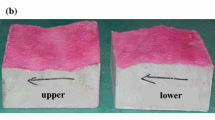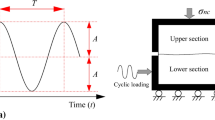Abstract
This study addresses the shear behavior of rectangular asperities on rock joints to highlight the role of asperity characteristics related to joint shear behavior. The shear strength and failure mode of a rectangular asperity are theoretically derived from force equilibrium analysis, and the relationship between shear strength and shear displacement of a unit asperity is obtained considering shear mechanisms and asperity characteristics. Two failure modes of a rectangular asperity are determined depending on its shape and critical aspect ratio: a dilative failure mode with an inclination of 45-ϕ f /2 and a non-dilative failure mode with shearing of asperity. The range of critical aspect ratio is 0.15 to 0.32 for general rocks. The shear strength of a rectangular asperity is also determined with peak friction angle, cohesion, basic friction angle, aspect ratio, and normal stress. Direct shear tests on artificial joints are performed to verify the theoretical analysis on a rectangular asperity and to explore the effect of asperity size distribution and progressive failure. Based on the analysis on a unit asperity, various effects, such as asperity geometric distribution, normal stress, and specimen size, are discussed in relation to the shear behavior of rock joints.
Similar content being viewed by others
References
Asef, M. R. and Reddish, D. J. (2002). “The impact of confining stress on the rock mass deformation modulus.” Geotechnique, Vol. 52, No. 4, pp. 235–241.
Bandis, S., Lumsden, A. C., and Barton, N. R. (1981). “Experimental studies of scale effects on the shear behaviour of rock joints.” International Journal of Rock Mechanics and Mining Science and Geomechanics Abstract, Vol. 18, No. 1, pp. 1–21.
Barton, N. (1986). “Deformation phenomena in jointed rock.” Geotech nique, Vol. 36, No. 2, pp. 147–167.
Barton, N. and Bandis, S. (1982). “Effects of block size on the shear behavior of jointed rock.” Proceeding of 23rd U.S. Symposium on Rock Mechanics, Berkeley, pp. 739–760.
Bhushan, B. (2002). Introduction to Tribology, John Wiley and Sons, New York.
Cunha, A. P. (1990). “Scale effects in rock mechanics.” Proceeding of 1st International Symposium on Scale Effects in Rock Masses, Scale Effects in Rock Masses, A. Pinto da Cunha (Ed.), Balkema, Rotterdam, pp. 3–27.
El-Soudani, S. M. (1978). “Profilometric analysis of fractures.” Metallography, Vol. 11, No. 3, pp. 247–336.
Goodman, R. E. (1989). Introduction to Rock Mechanics, 2nd Ed., John Wiley and Sons, New York.
Indraratna, B. (1990). “Development and application of a synthetic material to simulate soft sedimentary rocks.” Geotechnique, Vol. 40, No. 2, pp. 189–200.
Indraratna, B., Haque, A., and Aziz, N. (1998). “Laboratory modeling of shear behaviour of soft joints under constant normal stiffness condition.” Journal of Geotechnical and Geological Engineering, Vol. 16, No. 1, pp. 17–44.
Jeong, W. C., Kim, J. Y., and Song, J. W. (2004). “A numerical study on the influence of Fault zone heterogeneity in fractured rock media.” KSCE Journal of Civil Engineering, Vol. 8, No. 5, pp. 575–588.
Johnston, I. W. and Lam, T. S. K. (1989). “Shear behavior of regular triangular concrete/rock joints-analysis.” Journal of Geotechnical Engineering, Vol. 115, No. 5, pp. 711–727.
Kwon, T. H. (2004). Shear Behavior of Rock Joints — Microscale Characterization, Master Thesis, KAIST, Republic of Korea.
Kwon, T. H., Baak, S. H., and Cho, G. C. (2004). “Shear behaviour of idealized rock joints — Microscale analysis.” Tunnelling and Under ground Space Technology, Vol. 19, No. 4–5, pp. 535–535.
Ladanyi, B. and Archambault, G. (1970). “Simulation of shear behavior of a jointed rock mass.” Proceeding of 11th U.S. Symposium on Rock Mechanics, Berkeley, pp. 105–125.
Lam, T. S. K. and Johnston, I. W. (1989). “Shear behavior of regular triangular concrete/rock joints-evaluation.” Journal of Geotechnical Engineering. Vol. 115, No. 5, pp. 728–740.
Patton, F. D. (1966). “Multiple modes of shear failure in rock.” Proceeding of 1st Congress ISRM, Lisbon, pp. 509–513.
Seidel, J. P. and Haberfield, C. M. (1995a). “Towards an understanding of joint roughness.” Rock Mechanics and Rock Engineering, Vol. 28, No. 2, pp. 69–92.
Seidel, J. P. and Harberfield, C. M. (1995b). “The application of energy principles to the determination of the sliding resistance of rock joints.” Rock Mechanics and rock Engineering, Vol. 28, No. 4, pp. 211–226.
Seidel, J. P. and Haberfield, C. M. (2002a). “Laboratory testing of concrete-rock joints in constant normal stiffness direct shear.” Geotechnical Testing Journal, Vol. 25, No. 4, pp. 1–14.
Seidel, J. P. and Harberfield, C. M. (2002b). “A theoretical model for rock joints subjected to constant normal stiffness direct shear.” International Journal of Rock Mechanics and Mining Sciences, Vol. 39, No. 5, pp. 539–553.
Yang, Z. Y. and Chiang, D. Y. (2000). “An experimental study on the progressive shear behavior of rock joints with tooth-shaped asperities.” International Journal of Rock Mechanics and Mining Sciences, Vol. 37, No. 8, pp. 1247–1259.
Yang, Z. Y., Di, C. C., and Yen, K. C. (2001). “The effect of asperity order on the roughness of rock joints.” International Journal of Rock Mechanics and Mining Sciences, Vol. 38, No. 5, pp. 745–752.
Author information
Authors and Affiliations
Corresponding author
Rights and permissions
About this article
Cite this article
Kwon, TH., Hong, ES. & Cho, GC. Shear behavior of rectangular-shaped asperities in rock joints. KSCE J Civ Eng 14, 323–332 (2010). https://doi.org/10.1007/s12205-010-0323-1
Received:
Accepted:
Published:
Issue Date:
DOI: https://doi.org/10.1007/s12205-010-0323-1




